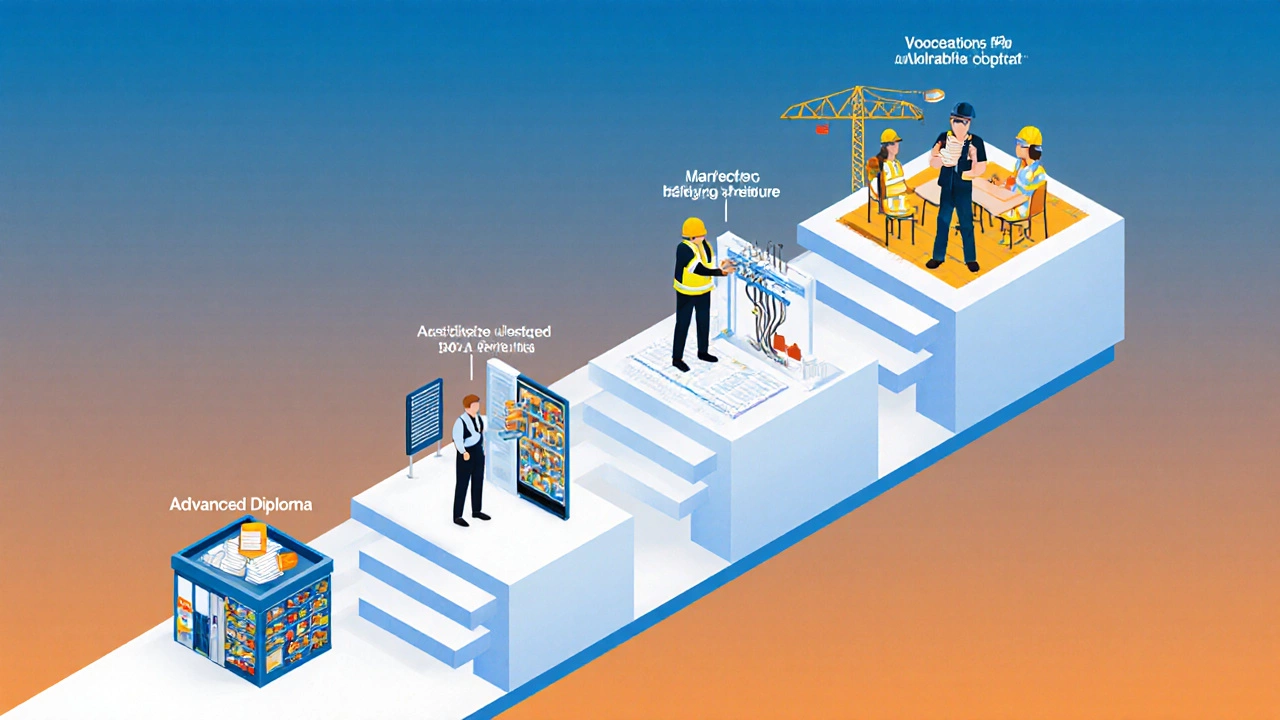Vocational Qualification Pathway Simulator
Start Your Pathway
Progression Pathways
Salary Impact
People often hear the term "vocational qualification" but aren’t sure what it really means or why it matters. If you’re wondering whether a skill‑focused credential can boost your job prospects, save you time, or help you switch careers, you’ve come to the right place. This guide breaks down the basics, walks you through the different types, and shows how to pick the right one for your goals.
Key Takeaways
- A vocational qualification is a skill‑focused credential recognized by the Australian Qualifications Framework (AQF).
- Levels range from Certificate I up to Advanced Diploma and include apprenticeships and traineeships.
- These qualifications can lead directly to jobs, higher wages, and pathways to further study.
- Choosing the right one involves checking industry demand, AQF level, delivery mode, and RTO accreditation.
- Australia offers clear routes through My Skills and TAFE institutions to start or upgrade your skills.
What is a Vocational Qualification?
Vocational Qualification is a skill‑based credential that aligns with the Australian Qualifications Framework (AQF) and prepares learners for specific occupations or industry roles. Unlike academic degrees, it focuses on practical abilities you can apply on the job from day one.
Types of Vocational Qualifications
Australia’s AQF defines several levels for vocational study. Here’s a quick rundown:
- Certificate I-IV: Entry‑level to intermediate skills, often used for roles like retail assistant or hospitality staff.
- Diploma: More in‑depth training for supervisory or specialist positions, such as aged care coordinator or project assistant.
- Advanced Diploma: Prepares you for senior technical or managerial roles, like civil construction supervisor.
- Vocational Graduate Certificate / Diploma: Short, specialised study for professionals already holding a higher‑education degree.
- Apprenticeship: Combines on‑the‑job training with a formal qualification, commonly in trades like electrician or plumber.
- Traineeship: Similar to an apprenticeship but geared toward non‑trade occupations, such as retail management.
How Does It Differ From an Academic Degree?
Both are AQF‑registered, but the focus, duration, and outcomes vary:
| Aspect | Vocational Qualification | Academic Degree |
|---|---|---|
| Primary Goal | Job‑ready skills | Theoretical knowledge |
| Typical Duration | 6 months - 2 years | 3 - 4 years |
| Delivery Mode | TAFE, RTOs, online short courses | Universities, colleges |
| Industry Alignment | High - designed with employers | Variable - research‑focused |
| Pathways | Stackable; can lead to higher AQF levels | Can lead to postgraduate study |

Benefits of Getting a Vocational Qualification
Here’s why many Australians choose this route:
- Faster entry into the workforce - most programs finish within two years.
- Higher earning potential - average salary boost of 10‑15% for certificate‑level graduates, according to the 2024 Skills Australia report.
- Industry relevance - curricula are co‑designed with employer groups like the Construction Skills Council.
- Flexibility - you can study part‑time, online, or on‑site while working.
- Clear progression routes - credits often transfer to a Diploma or even a Bachelor’s degree.
How to Choose the Right Vocational Qualification
Follow these steps to ensure you pick a credential that matches your goals:
- Identify your target industry. Use the My Skills website to see which qualifications are in demand.
- Check the AQF level. Higher levels (Diploma, Advanced Diploma) typically lead to higher‑paid roles.
- Confirm RTO accreditation. Only Registered Training Organisations (RTOs) can issue nationally recognised qualifications.
- Consider delivery mode. If you’re working, look for blended or fully online options.
- Look at career pathways. See if the qualification offers credit transfer to further study or aligns with apprenticeship pathways.
Pathways and Progression
Vocational learning is designed to be stackable. After completing a Certificate III in Plumbing, you can:
- Enter an apprenticeship to become a licensed plumber.
- Upgrade to a Diploma in Building Services Engineering.
- Transfer credits to a Bachelor of Engineering (Honours) at a university.
This flexibility means you’re never locked into a single path.

Common Misconceptions
Many people think vocational qualifications are only for low‑skill jobs. In reality:
- Advanced Diplomas lead to senior technical management roles.
- Graduate certificates offer specialised knowledge for engineers, accountants, and health professionals.
- Employers value the practical focus, often rating vocational grads as “job‑ready” higher than academic grads.
Getting Started in Australia
Ready to begin? Here’s a quick guide:
- Visit My Skills and search for the occupation you’re interested in.
- Note the recommended AQF level and typical RTOs offering the course.
- Verify RTO status on the National Register of VET.
- Check eligibility for government subsidies like the VET Student Loan if you meet the income criteria.
- Enroll and start studying - many courses now offer instant online access.
Frequently Asked Questions
What’s the difference between a Certificate III and a Diploma?
A Certificate III provides foundation‑level skills for a specific trade or service role, while a Diploma offers deeper technical knowledge and prepares you for supervisory or specialist positions. Both are nationally recognised, but the Diploma sits higher on the AQF ladder, often leading to higher pay.
Can I use a vocational qualification to get into university?
Yes. Many universities accept credit from Certificates, Diplomas, and Advanced Diplomas toward a Bachelor’s degree, especially in fields like engineering, health, and business. Check the university’s credit‑transfer policy before enrolling.
Are vocational qualifications government‑funded?
Some are. Programs like the VET Student Loan, state‑based training grants, and apprenticeships often come with government subsidies. Eligibility depends on your age, income, and the specific course.
How long does it take to become a qualified electrician?
Typically you complete a Certificate III in Electrotechnology (Electrical) - about 1.5years - and then start a four‑year apprenticeship. The combined pathway usually takes around 5‑6years to full licensure.
Do employers recognise overseas vocational qualifications?
Recognition varies. If the qualification aligns with the AQF and is issued by a recognized body, many Australian employers will accept it, often after an assessment by the Australian Skills Recognition board.
Whether you’re fresh out of high school, looking to upskill, or planning a career switch, a vocational qualification can give you the practical edge you need. Start exploring your options today and turn the skills you learn into real‑world opportunities.






Write a comment: